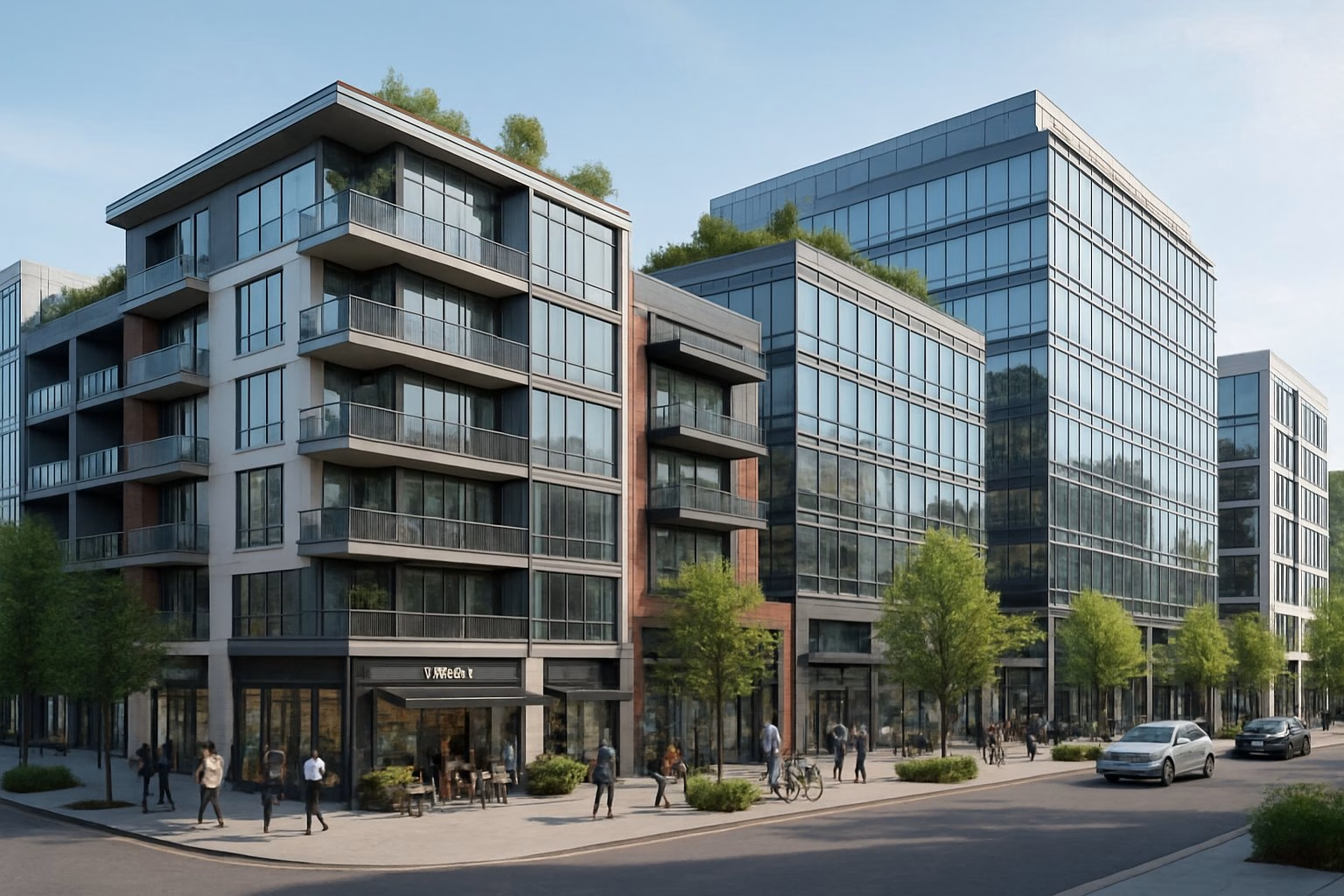Interest rates and cap rates move through commercial real estate markets like interconnected gears, but their relationship is more complex than most investors realize. When the Federal Reserve adjusts interest rates, property values don’t simply follow a predictable formula. Historically, cap rates and interest rates show a 0.7 correlation, but cap rates can move opposite to interest rates during certain market periods because of factors like capital availability, supply constraints, and investor risk appetite.
Your investment returns depend on knowing how these financial mechanisms work together rather than assuming they move in lockstep. Commercial real estate transaction volumes fell 30% in 2023, making this knowledge important for timing acquisitions and exits. Rising interest rates don’t automatically mean higher cap rates across all property types and markets.
The current environment brings both challenges and opportunities for real estate investors who grasp these dynamics. While higher borrowing costs pressure property values, cap rates have expanded by 190 basis points across core sectors, potentially setting up favorable entry points for well-capitalized investors. Knowing these relationships helps you move through market cycles and optimize your portfolio performance.
Key Takeaways
- Cap rates and interest rates show a 0.7 correlation historically but don’t always move together due to market-specific factors
- Rising interest rates typically pressure property values downward while expanding cap rates across most commercial sectors
- Current market conditions with elevated cap rates may present strategic acquisition opportunities for prepared investors
Cap Rates and Interest Rates Explained
Cap rates represent your property’s annual return based on net operating income, while interest rates determine your borrowing costs and influence property valuations. These two metrics shape your investment returns and property purchase decisions.
Cap Rate Fundamentals and Calculation
A capitalization rate measures the ratio of a property’s net operating income to its purchase price. This metric tells you what annual return you can expect from your real estate investment before financing costs.
Cap Rate Formula:
Cap Rate = Net Operating Income (NOI) ÷ Property Value × 100
If your commercial property generates $100,000 in NOI and costs $1,250,000, your cap rate equals 8%. Higher cap rates indicate either higher returns or higher risk properties.
Cap rates vary significantly by property type and location. Office buildings typically range from 4-8%, while retail properties might offer 6-10% cap rates depending on tenant quality and lease terms.
Your cap rate also functions as a valuation tool. When you know a property’s NOI and target cap rate, you can determine its fair market value by dividing NOI by the cap rate.
Interest Rates and the Cost of Borrowing
Interest rates affect your financing costs and influence how much you’re willing to pay for investment properties. When rates rise, your monthly debt service increases, reducing your cash-on-cash returns.
Higher interest rates make borrowing more expensive across all loan types. A 1% increase in rates on a $1 million loan adds roughly $10,000 annually to your debt service costs.
Impact on Investment Decisions:
- Higher rates = Lower property values you’re willing to accept
- Lower rates = Higher prices you can justify paying
- Rate changes = Shifts in investor demand and competition
Rising rates also affect your leveraged returns differently than all-cash purchases. If your cap rate is 6% but borrowing costs 7%, leverage reduces your returns instead of amplifying them.
Your financing strategy should account for rate environments. Fixed-rate loans protect against future increases, while variable rates might offer initial savings but carry risk if rates climb.
Role of Net Operating Income (NOI) in Cap Rates
Net operating income forms the foundation of cap rate calculations and represents your property’s actual earning power. NOI includes all rental income minus operating expenses, but excludes debt service and depreciation.
NOI Components:
- Income: Base rent, parking fees, common area charges, escalations
- Expenses: Property taxes, insurance, maintenance, management fees, utilities
Your NOI directly drives property value through the cap rate relationship. A $10,000 increase in annual NOI at a 6% cap rate adds approximately $167,000 to your property’s value.
Knowing your NOI helps you anticipate how interest rate changes affect your investment. When rates rise and cap rates follow, properties with stable NOI maintain more value than those with declining income.
Property improvements that boost NOI become more valuable in rising rate environments. Adding $5,000 in annual NOI provides greater value preservation than hoping for cap rate compression when rates are climbing.
The Impact of Interest Rates on Cap Rates
Interest rates influence your property values through their effect on capitalization rates, creating a complex relationship that affects borrowing costs, risk premiums, and investment returns. The relationship between cap rates and interest rates involves multiple factors including Federal Reserve policy, inflation expectations, and commercial real estate market dynamics.
Direct Relationship Between Interest Rates and Cap Rates
When interest rates rise, your borrowing costs increase, which typically leads to higher cap rates and lower property values. Investors usually demand higher returns to compensate for the increased cost of debt financing.
Cap rates measure the ratio of a property’s net operating income to its purchase price. As interest rates climb, the cost of borrowing money rises, reducing the pool of qualified buyers for investment property.
Key Effects of Rising Interest Rates:
- Higher financing costs reduce your cash flow
- Decreased property demand leads to lower valuations
- Cap rates expand as property prices decline
- Your required returns increase to offset higher borrowing costs
This relationship isn’t always linear. Historical data shows cap rates don’t necessarily move in lockstep with interest rates, with correlations ranging from -0.82 to 0.79 over different time periods.
Risk Premium and Spread Analysis
The spread between cap rates and Treasury yields represents the risk premium you expect for investing in commercial real estate versus risk-free government bonds. This spread changes based on your risk tolerance and market conditions.
During periods of economic uncertainty, you typically require a wider spread to compensate for additional risk. Conversely, when market confidence is high, cap rate spreads compress as investors accept lower risk premiums.
Factors Affecting Risk Premiums:
- Credit availability – More accessible financing compresses cap rates
- Market liquidity – Limited transaction volume expands spreads
- Property type risk – Office properties show higher volatility than multifamily
- Geographic factors – Market-specific supply and demand dynamics
Cap rate spreads to Treasury yields often compress when economic growth offsets the effects of rising interest rates on your investment decisions.
Influence of Inflation and Federal Reserve Policy
The Federal Reserve’s monetary policy affects your real estate investments through its impact on both nominal and real interest rates. Inflation expectations play a key role in determining how interest rate changes affect cap rates.
Real estate often serves as an inflation hedge, so your rental income can increase with rising prices. When interest rate increases stem from inflation rather than real rate changes, the impact on cap rates may be less severe.
Federal Reserve Policy Effects:
- Rate cuts typically compress cap rates and increase property values
- Quantitative easing increases capital availability for commercial real estate
- Forward guidance influences your investment timing decisions
CBRE research shows that for every 100-basis-point change in the 10-year Treasury yield, cap rates historically adjust by a measurable amount. However, the relationship varies by property type and market conditions.
Inflation affects your real returns differently than nominal returns. When inflation drives interest rate increases, your property’s income-generating potential may improve through rent escalations.
Market Dynamics in Commercial Real Estate
Commercial real estate markets react to interest rate changes through several channels beyond just financing costs. Capital flows, investor sentiment, and transaction volumes all shape how cap rates shift with interest rate movements.
Transaction volumes fell 30% year-over-year during recent periods of rising rates, putting pressure on prices and leading to cap rate increases. When fewer transactions occur, price discovery becomes more difficult and valuations may lag behind market trends.
Market Response Factors:
- Capital availability – Tighter lending raises cap rates
- Investor competition – Fewer buyers cause cap rates to rise
- Property fundamentals – Strong rental growth helps support values
- Alternative investments – Other asset classes can shift demand
Consider these market dynamics when you evaluate how interest rate changes could influence your property values. Cap rates across core sectors rose by 190 basis points from recent peak valuations, with office and multifamily properties seeing the biggest changes.
Market adjustments don’t happen at the same pace everywhere. Private market valuations often take longer to reflect changes than public markets, since they rely on appraisals and have fewer transactions.
Frequently Asked Questions
Interest rate changes often lead to predictable cap rate patterns, with rising rates pushing cap rates higher and falling rates compressing them. These shifts directly affect your property values and investment returns throughout different market cycles.
How do rising interest rates typically influence capitalization rates in real estate investments?
Rising interest rates usually push cap rates higher because borrowing becomes more expensive for investors. As debt costs go up, you need higher returns from your properties to keep your profit margins where you want them.
The relationship between interest rates and cap rates shows that property values drop as cap rates rise. Your existing properties might lose value since new buyers will want higher yields to offset increased financing costs.
This effect isn’t the same everywhere. Prime assets in strong markets tend to have smaller cap rate changes than secondary properties when rates rise.
What is the correlation between cap rate trends and changes in interest rates over an economic cycle?
Cap rates and interest rates often move together in commercial real estate. When the economy grows, rates and cap rates usually rise; during recessions, both tend to fall. The strength of this link depends on market conditions and investor mood, and sometimes strong property fundamentals keep cap rates steady even as rates climb.
Can an increase in interest rates lead to cap rate expansion in commercial real estate?
Yes, when interest rates go up, cap rates in commercial real estate sectors usually increase too. Higher borrowing costs mean fewer qualified buyers and lower prices for properties, but this shift happens gradually as new deals reflect the current market. Class A properties in top markets often see smaller cap rate increases than lower-grade assets.
How do fluctuations in the Federal Reserve’s interest rates impact real estate cap rates?
Changes in the Federal Reserve’s rates affect the whole yield curve and influence real estate pricing. When the Fed raises rates, your cost of capital goes up and cap rates usually follow, mostly because bank lending rates, bond yields, and return expectations all move higher. Fed policy changes can cause temporary market swings, so it helps to consider both current rates and where policy might be headed.
In what ways do lenders’ interest rates affect the cap rates used in property valuation?
Lender rates directly affect the debt service coverage ratios you can achieve at various cap rates. Higher loan rates lower the maximum price you can pay for a property’s cash flow, and banks usually want coverage ratios between 1.20 and 1.40 times net operating income. Properties with assumable low-rate loans often trade at lower cap rates than similar ones needing new financing.
What risk considerations are associated with cap rate movements in response to changing interest rates?
Interest rate volatility brings timing risk to your property acquisitions and sales. Rapid rate changes can shift cap rates and directly impact transaction prices.
Leverage increases your exposure to cap rate changes. When you have a high loan-to-value ratio, your property’s value will swing more when cap rates move with interest rates.
Timing your exit strategy becomes especially important during periods of changing rates. If you buy at a low cap rate and rates rise before you sell, your property’s value may drop.
Ever wish you could analyze properties like the pros?
Save time and make smarter investment decisions with the most powerful real estate analysis software on the market.
Enter the code BESTDEAL at check out and receive a 20% Off Discount!

Dive deep into the world of real estate investment with this comprehensive case study that brings theory to life.
Investment Real Estate Analysis: A Case Study offers an unparalleled look at the decision-making process behind successful property investments. Follow along as we dissect a real-world scenario, revealing the critical factors that seasoned investors consider before making a move.
From crunching numbers to assessing market conditions, this book walks you through every step of the analysis process. Learn how to evaluate potential investments like a pro, understanding key metrics such as cap rates, cash-on-cash returns, and internal rate of return.
Whether you’re a novice investor or looking to refine your skills, this case study will equip you with the tools to make informed investment decisions in the competitive real estate market.
Get your copy now from your favorite bookseller:
- Amazon
- Books2Read for Apple, Barnes & Noble, Kobo, Scribed, and 8 more sellers with both eBook and paperback options available
- Payhip as a downloadable PDF
Ready to take your business to the next level?
- Subscribe to our newsletter
- Visit the learning center
- Learn more about our consulting services



